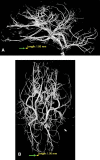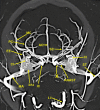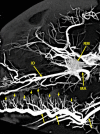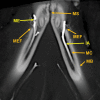High-Resolution Computed Tomography Imaging of the Cranial Arterial System and Rete Mirabile of the Cat (Felis catus)
- PMID: 31502384
- PMCID: PMC6856801
- DOI: 10.1002/ar.24251
High-Resolution Computed Tomography Imaging of the Cranial Arterial System and Rete Mirabile of the Cat (Felis catus)
Abstract
The objective of this study was to investigate the possibility of obtaining high-resolution multiplanar computed tomography (CT) imaging of the cranial arterial circulation of the cat (Felis catus), the rete mirabile, and components of the skull, utilizing preserved cat specimens with an arterial system that was injected with a radiopaque contrast compound in the early 1970s. Review of the literature shows no high-resolution CT studies of the cat's cranial circulation, with only few plain radiographic studies, all with limited cranial vascular visualization. In view of the inability of the radiographic techniques available from 1970s to mid-2000s to provide high-resolution imaging of the arterial circulation within the intact skull and brain of the cat, without dissection and histologic sectioning and disruption of tissues, no further imaging was performed for many years. In 2010, a high-resolution micro CT scanner became available, large enough to scan the entire nondissected head of the arterially injected cats. All the obtained CT images were processed with a software program that provided 3D volume rendering and multiplanar reconstruction with the ability to change the plane angulation and slab thickness. These technical features permitted more precise identification of specific arterial and bony anatomy. The obtained images demonstrated, with a nondestructive method, high-resolution vascular anatomy of the cerebral, orbital, facial arterial system, the rete mirabile, and skull bone components of the cat, with details not previously described in the literature. Anat Rec, 302:1958-1967, 2019. © 2019 The Authors. The Anatomical Record published by Wiley Periodicals, Inc. on behalf of American Association of Anatomists.
Keywords: Felis catus; carotid rete; cat; cerebral arteries; extracranial rete; facial arteries; infraorbital canal; lacrimal canal; multiplanar high-resolution micro-computed tomography (CT); orbital arteries; rete mirabile; skull bones; sphenopalatine foramen.
© 2019 The Authors. The Anatomical Record published by Wiley Periodicals, Inc. on behalf of American Association of Anatomists.
Conflict of interest statement
The authors declare no competing or financial interest.
Figures












Similar articles
-
Fascinating wonderful network: Rete mirabile of the maxillary artery in cats - minireview.Vet Res Commun. 2024 Feb;48(1):11-18. doi: 10.1007/s11259-023-10181-3. Epub 2023 Jul 31. Vet Res Commun. 2024. PMID: 37525064 Free PMC article. Review.
-
[Corrosion anatomical studies of the rete mirabile and the brain basal vessels of pygmy goats].Gegenbaurs Morphol Jahrb. 1988;134(4):585-95. Gegenbaurs Morphol Jahrb. 1988. PMID: 3224795 German.
-
Extra- and intra-cranial blood supply to brains of dog and cat.Am J Anat. 1976 Jul;146(3):237-53. doi: 10.1002/aja.1001460303. Am J Anat. 1976. PMID: 941852
-
Rete mirabile of posterior inferior cerebellar artery: A rare cause of subarachnoid hemorrhage.Interv Neuroradiol. 2018 Dec;24(6):662-665. doi: 10.1177/1591019918782147. Epub 2018 Jul 4. Interv Neuroradiol. 2018. PMID: 29973082 Free PMC article.
-
Rete mirabile associated with pial arteriovenous fistula: imaging features with literature review.BMJ Case Rep. 2017 Feb 16;2017:bcr2016012939. doi: 10.1136/bcr-2016-012939. BMJ Case Rep. 2017. PMID: 28209646 Free PMC article. Review.
Cited by
-
The Arteries of the Encephalon Base in Caracal (Caracal caracal; Felidae; Carnivora).Animals (Basel). 2023 Dec 7;13(24):3780. doi: 10.3390/ani13243780. Animals (Basel). 2023. PMID: 38136817 Free PMC article.
-
Strategies of vascularization of the ethmoid labyrinth in selected even-toed ungulates (Artiodactyla) and carnivores (Carnivora).J Anat. 2023 Jun;242(6):1067-1077. doi: 10.1111/joa.13829. Epub 2023 Jan 23. J Anat. 2023. PMID: 36688531 Free PMC article.
-
Domestic cat's internal carotid artery in ontogenesis.Vet Med (Praha). 2021 Jun 1;66(7):292-297. doi: 10.17221/116/2020-VETMED. eCollection 2021 Jul. Vet Med (Praha). 2021. PMID: 40201395 Free PMC article.
-
Coexistence of anterior choroidal artery and posterior cerebral artery retia mirabilia presenting with subarachnoid hemorrhage: illustrative case.J Neurosurg Case Lessons. 2024 Jan 1;7(1):CASE23580. doi: 10.3171/CASE23580. Print 2024 Jan 1. J Neurosurg Case Lessons. 2024. PMID: 38163352 Free PMC article.
-
Fascinating wonderful network: Rete mirabile of the maxillary artery in cats - minireview.Vet Res Commun. 2024 Feb;48(1):11-18. doi: 10.1007/s11259-023-10181-3. Epub 2023 Jul 31. Vet Res Commun. 2024. PMID: 37525064 Free PMC article. Review.
References
-
- du Boulay G, Darling M. 1975. Autoregulation in external carotid artery branches in the baboon. Neuroradiology 9:129–132. - PubMed
-
- du Boulay GH, Verity PM. 1973. The cranial arteries of mammals. London: W. Heinemann.
-
- du Boulay G, Kendall BE, Crockard A, Sage M, Belloni G. 1975. The autoregulatory capability of Galen's rete cerebri and its connections. Neuroradiology 9:171–181. - PubMed
-
- Chiasson RB, Booth ES. 1973. Laboratory anatomy of the cat. Dubuque, Iowa: WM. C. Brown Company.
MeSH terms
LinkOut - more resources
Full Text Sources
Medical
Miscellaneous

